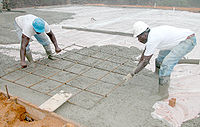
Photo from wikipedia
To improve both seismic performance and thermal insulation of low-rise housing in rural areas of China, this study proposes a load-bearing prefabricated composite wall panel structure that achieves appropriate seismic… Click to show full abstract
To improve both seismic performance and thermal insulation of low-rise housing in rural areas of China, this study proposes a load-bearing prefabricated composite wall panel structure that achieves appropriate seismic performance and energy efficiency using field-assembled load-bearing prefabricated composite wall panels. A 1:2 scale prototype built using load-bearing prefabricated composite wall panel is subjected to quasi-static testing so as to obtain damage characteristics, load-bearing capacity and load–displacement curves in response to a simulated earthquake. As a result, seismic performance indicators of load-bearing capacity, deformation and energy-dissipating characteristics, are assessed against the corresponding seismic design requirements for rural building structures of China. Experimental results indicate that the earthquake-resistant capacity of the prototype is 68% higher than the design value. The sample has a ductility factor of 4.7, which meets the seismic performance requirement mandating that the ductility factor of such concrete structures should exceed 3. The design can be further optimized to save the consumption of material. This shows that the load-bearing prefabricated composite wall panel structure developed here has decent load-bearing capacity, ductility and energy dissipation abilities, a combination of which is in line with the seismic design code. A new construction process proposed here based on factory prefabrication and field assembly leads to a considerable reduction of energy consumption.
Journal Title: Advances in Structural Engineering
Year Published: 2020
Link to full text (if available)
Share on Social Media: Sign Up to like & get
recommendations!